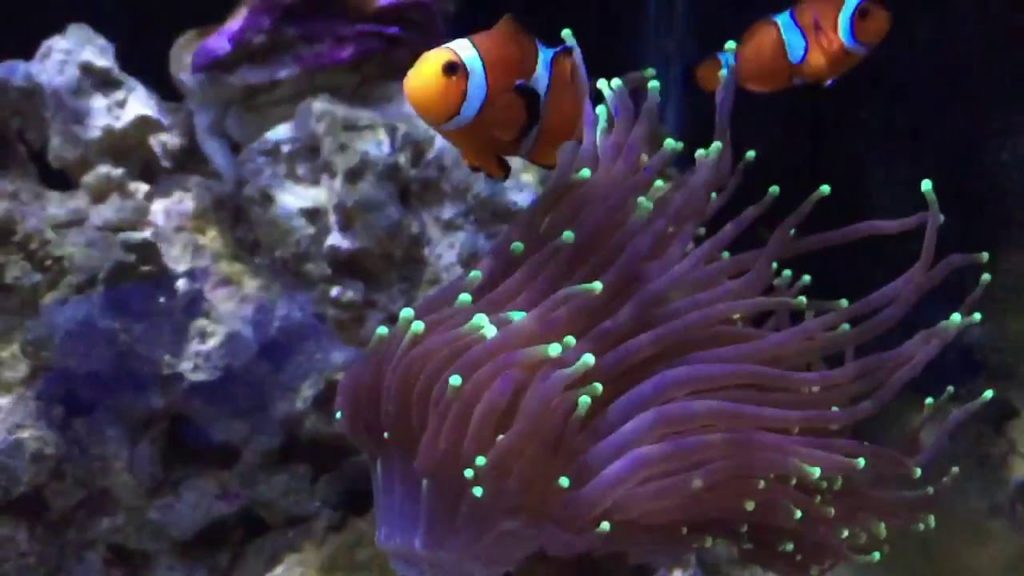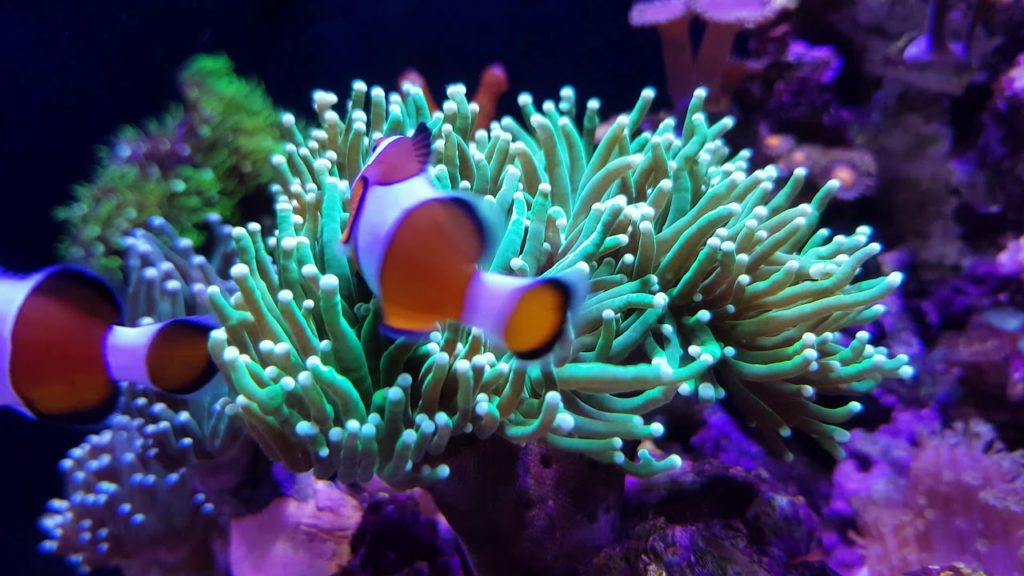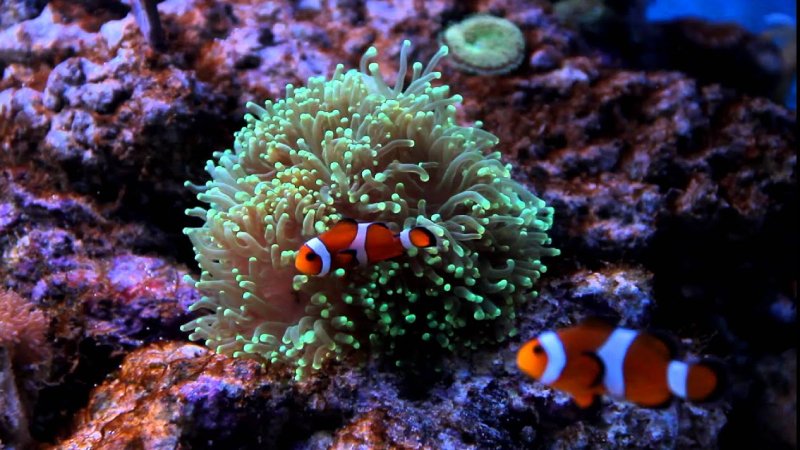In the ocean, both torch coral and clownfish live at a depth of 30-150 feet. They are brightly coloured to warn predators that they are poisonous. These beautiful fish have an interesting symbiotic relationship with one another; torch corals provide shelter for clownfish, and in return, the clownfish protect torch corals from predators.
When they live together, they can create a beautiful symbiotic relationship that is fascinating to watch and provides benefits for both animals. Learn about this great relationship with this blog post!
See also:
- Clownfish Hosting Hammer Coral – Top 4 Facts About Hammer Coral
- What Is The Best Coral For Clownfish To Host?
- Coral Beauty Angelfish With Clownfish? (Top 2 Facts)
What Makes Torch Coral Suitable For Clownfish?
Clownfish live in the water under the protection of corals and sea anemones, or “host” them. Sea anemones and corals are quite different, with corals having a skeleton and being tougher, whilst anemones are soft, filled with water, and maybe extremely mushy.
Clownfish and Anthozoans (Anemones and Corals) have a symbiotic connection in which the hosts give refuge and protect the fish from predators, while the fish supply nutrients and clean the remnants of other fish’s algae.
Though your pet clownfish will thrive without Anthozoans in their tank, they have been protected for centuries, and it is instinctual for them to do so. Anemones and corals are also attractive. They can improve the appearance of your aquarium. As a result, a small ‘ocean’ within your house may easily enchant visitors.
Torch corals, which have lighted tips that resemble slender torches, are another attractive coral species. These feature enormous, tubular tentacles and are typically bi-coloured, with distinct colours for the tentacles and other colours for the tips, giving them a lighted appearance.
Despite their beauty, certain clownfish can destroy corals and stifle development with their “nuzzling.” However, certain clownfish, like the Oscillera, are capable of hosting Torch Corals without difficulty.
Can Clownfish Host Torch Coral?
Yes, Torch Coral may be found in clownfish. This can sometimes lead to beneficial outcomes. Other times, it all goes horribly wrong, particularly for the torch coral. The connection between clownfish and torch coral can be a touchy subject.

I’ll go into more detail about clownfish and torch corals later in this essay. This will assist you in creating a symbiotic relationship between the two. For the time being, let’s concentrate on whether or not the two can truly coexist.
Due to their resemblance to anemones, some people may mistakenly assume that clownfish will host torch corals. While most fishkeepers are aware of the close relationship that anemones and clownfish have, sweeping generalizations can be deceptive.
First and foremost, it is critical to distinguish between anemones and torch corals. They are both members of the same phylum (Phylum Cnidaria). However, they are quite distinct animals. They both have tentacles that float in the water, ready to sting victims, and they both appear like flowers. They can also exist on their own or in groups.
The way anemones and torch corals have constructed the most fundamental distinction between them. Because anemones are filled with water, they are soft and squishy. Torch corals, on the other hand, have an absolute skeleton formed of calcium carbonate.
Their mobility is another significant distinction. Anemones have the ability to move. Torch corals are immobile. They will remain in a certain spot after you have placed them there. This is why it is recommended that you place them in an appropriate location in the tank where they will receive ample light. They are unable to alter their posture in the aquarium on their own.
The connection between torch corals and clownfish is important because torch corals have a tendency to sting fish who spend too much time near them. This is why you should carefully choose your torch coral’s tankmates.
You should seek fish that will not bother your corals. They will bear the repercussions if they do not. You don’t have to be concerned about clownfish succumbing to the same destiny. They have mucus covering all over their body that protects them against animals like torch corals and anemones stinging them.
If you look closely, you can see your clownfish rubbing against the torch coral’s tentacles. This helps them to develop more tolerance to the sting of their venom. However, clownfish may get stung as a result of this procedure. If your clownfish develop black markings after rubbing against the tentacles of a torch coral, it’s likely that they were injured.
Is it possible for a clownfish to host a torch coral? Yes, it is possible. Is it possible for a clownfish to host a torch coral? That, of course, is dependent on the fish. Clownfish are always refusing to host torch corals. As a result, it’s not a matter of whether they’ll be able to live inside the coral.
They can stay safe within the creature’s tentacles due to their resilience to the creature’s sting. Clownfish, on the other hand, are typically willing to overlook torch corals. Isolating the two will encourage them to host the coral. However, you should generally leave it up to your clownfish to determine whether or not they wish to host their new friend.
Rather than being concerned about your clownfish’s capacity to host torch corals, consider whether it is a good idea to foster a relationship between the two. Remember that clownfish do not require the use of a torch coral to thrive. In fish tanks, this is especially true.
Both animals will live if the clownfish decides to disregard your torch coral. However, if a clownfish decides to take up residence in a torch coral, it may be fatal. Clownfish bite at the tentacles of torch corals to groom them. The coral may get stressed as a result of this activity. The torch coral may perish if the clownfish refuses to relent.
Many aquarium owners are more anxious about the harm their clownfish will cause to their torch coral than about the fish’s ability to host in it. If you are concerned about the clownfish’s behaviour endangering your torch coral, you may either remove the clownfish from the tank or add an anemone. The clownfish will abandon the torch coral after it has established itself in the anemone.
The Facts Of Things About Torch Coral And Clownfish
The delicate ecosystem of your aquarium is made up of anthozoans and clownfish. While it is simple to care for them after they have settled in, there are a few things to remember before adding a new coral or anemone to your aquarium.

The first and most essential guideline is that corals and anemones should not be kept together in the same aquarium. Anemones sting and are capable of killing corals as well as other fish. When people are touched, they will sting them lightly. As a result, you must use caution when dealing with them. Clownfish have a slimy coating covering their bodies that protects them from stinging and allows them to coexist.
Water conditions
Different water conditions are required depending on the species. You should acclimatize the water in your aquarium ahead of time and make sure it is kept clean. Water salinity, pH, and temperature should all be kept at a level that is comfortable for your Anthozoa.
Light conditions
Some of these hosts have the ability to photosynthesize as well. They are exposed to and adapted to varying levels of sunshine depending on where they naturally exist in the water.
According to the species, this must be maintained, and suitable lighting sources should be put within the tank. Bubble Tip Anemones, for example, demand high-output illumination or LED lights. For the host to flourish, they must be present in the aquarium.
Placement
It’s also crucial to consider where you’ll put your host candidate. This is due to the fact that certain Anthozoa moves about a lot while others are almost motionless. So, depending on how they act, they must be placed in a manner that allows them to develop and coexist with the other creatures in the tank.
Some hosts may even spread to other parts of the tank, such as pipelines, pumps, and filters. Anemones such as the Bubble Tip are frequently pulled into the pumps. As a result, make sure they’re well-protected ahead of time.
Compatibility
While corals and anemones are ideal companions for clownfish, this isn’t the case for every fish. They can be harmful to the aquarium’s ecosystem. The majority of each species eats other fish as well. As a result, be sure that the presence of a coral or anemone will not damage any other fish in the tank.
Size of aquarium
This is a lot more visible, but some species of corals and anemones may grow and reproduce in enormous numbers, resulting in a lot of space being taken up. So, before you go out and get a new one, consider the size of your current tank to ensure that it does not become congested.
Feeding
Even though you’re bringing in the host for your clownfish, keep in mind that the host is alive, breathing entity in its own right. However, not all corals and anemones need to be fed regularly because they can obtain nourishment from the clownfish.
Protein is typically required, and little cut-up pieces of fish are ideal. As a result, it’s advisable to store up on them and feed them as needed. Always remember to exercise caution when touching them because they might sting.
Some Other Related Questions
Can a torch coral host a clownfish?
Clownfish will live in torch corals, but the clownfish will most likely destroy it with their “nuzzling.” When clownfish begin to interact with the coral, they will never fully grow.
Will clownfish kill torch coral?
Both animals will live if the clownfish decides to disregard your torch coral. However, if a clownfish decides to take up residence in a torch coral, it may be fatal.
Does torch coral sting fish?
Community Member. They don’t harm your fish but I would recommend wearing gloves when touching them if you get a torch or a hammer, I got stung by my torches once it really burns and puts a hole in your skin!
Conclusions
Clownfish are known to live in torch corals. To make this more possible, you should customize your aquarium to meet the needs of each individual. Place the coral, for example, near the bottom of the tank. Choose a location with ample space for it to spread.
Feeding your clownfish should also be done on a regular basis. Keep in mind that the fish is more prone to acquire aggressive behaviour. If it is well-fed, however, it is less prone to nibble on the torch coral tentacles.

Annette M. Chaney is an experienced marine biologist with over 20 years of experience as an aquarist and fishkeeper. She started her first aquarium at a young age, filling it with frogs and goldfish obtained from the ten-cent pet store.
Annette grew up caring for and breeding African Cichlids, which led to a hobby in high school that doubled as a profitable means. Attending Reed College gave her time to solidify herself as an accomplished aquarium caretaker with an eye for sales. After that, from 2009 – 2013, she studied at Roger Williams University – one of the most prestigious universities for Aquaculture and Aquarium in USA. She is the founder of AquariumCircle since 2010.
